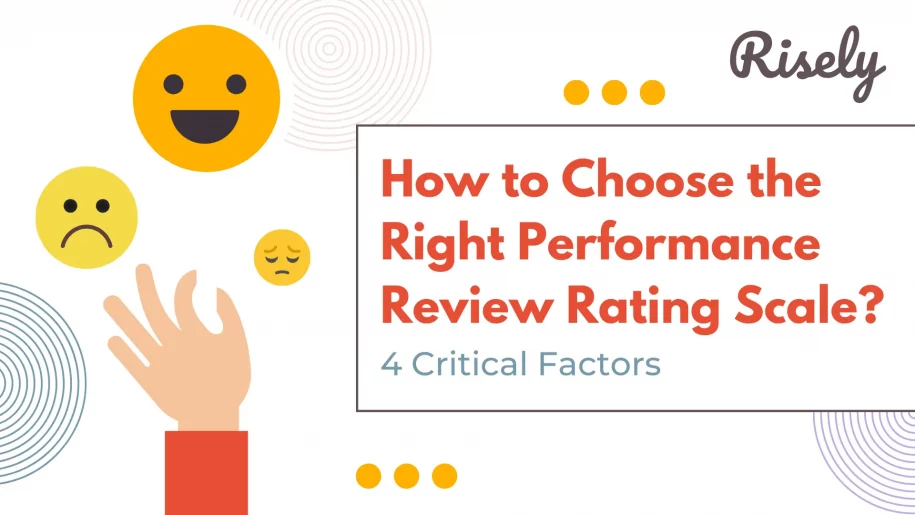How to Choose the Right Performance Review Rating Scale? 4 Critical Factors
As a manager, you understand the importance of giving your team performance feedback. You also know that implementing a performance review rating scale can help streamline the process. But with so many options available, how do you choose the right one? In this blog post, we will dive into why you need a performance review rating scale and the importance of choosing the right one. We will also discuss factors to consider while selecting a rating scale, including employee engagement and satisfaction, simplicity and clarity, flexibility and scalability, and accuracy and objectivity. Additionally, we’ll explore the different performance review rating scales available. Lastly, we will detail how to create your custom rating scale and best practices for implementing it effectively.- How to Choose the Right Performance Review Rating Scale? 4 Critical Factors
- Why Do You Need a Performance Review Rating Scale?
- Why don’t most performance review rating scales work?
- Importance of Choosing the Right Performance Review Rating Scale
- How do you choose the right Performance Review Rating Scale? Factors to Consider
- Types of Performance Review Rating Scales
- How to Create a Custom Performance Review Rating Scale?
- Conclusion
- Other Related Blogs
Why Do You Need a Performance Review Rating Scale?
A performance review rating scale provides several benefits for employees and employers. Here are some reasons why a performance review rating scale is important:- Consistency: A rating scale ensures that all employees are evaluated using the same criteria, allowing for fair and consistent assessments across the organization.
- Clear expectations: The rating scale provides clear guidelines for different performance levels, making it easier for employees to understand what is expected of them.
- Feedback and development: Using a rating scale, managers can provide specific feedback to employees on their strengths and areas for improvement. This feedback can then create individual development plans and support professional growth.
- Objective evaluation: A rating scale helps mitigate bias and subjectivity in the performance review process by providing an objective framework for assessing employee performance.
- Performance differentiation: With a rating scale, managers can differentiate between high-performing, average, and underperforming employees more effectively. This differentiation allows for better talent management decisions, such as identifying top performers for promotions or addressing performance issues.
Why don’t most performance review rating scales work?
Most performance review rating scales may not work effectively for a few reasons:- They often oversimplify complex job performance by reducing it to a single number or rating, which may not accurately capture the full range of an employee’s contributions or areas for improvement.
- Rating scales can be subjective and biased, as managers may interpret and apply them differently. This can result in inconsistent evaluations across teams and organizations.
- Rating scales focus on past performance rather than future potential or development opportunities.
Importance of Choosing the Right Performance Review Rating Scale
Choosing the right performance review rating scale ensures accurate and meaningful evaluations. It allows nuance and differentiation in employee performance ratings, addressing leniency and central tendency bias. A well-selected rating scale aligns with the organization’s goals and values, while customizing it to specific competencies and job requirements improves its effectiveness. By considering these factors, management teams can create an employee rating scale that promotes fair and transparent evaluations.Other Interesting Reads
How do you choose the right Performance Review Rating Scale? Factors to Consider
Employee Engagement and Satisfaction
A well-designed employee performance rating scale enhances employee engagement and satisfaction. The rating scale promotes a sense of ownership and involvement by allowing employees to participate in the review process actively. It also encourages open and constructive dialogue between managers and employees, fostering a positive work environment. An employee-centric rating scale, including a neutral option, captures accurate feedback and increases motivation. Implementing these practices can significantly impact employee engagement and satisfaction. Read more: 5 Ways Performance Management and Employee Engagement Impact Your TeamSimplicity and Clarity
Choosing a performance review rating scale that is simple and easy to understand is essential. It helps reduce ambiguity and improves the accuracy of evaluations. Avoiding complex rating scales that may confuse managers and employees is essential. Make sure the rating scale has clear descriptions for each rating level, and consider using a Likert scale or similar format for simplicity and clarity.Flexibility and Scalability
A key consideration when choosing a performance review rating scale is its flexibility and scalability. The scale should accommodate different job roles and responsibilities, allowing for adjustments based on individual or team goals. Additionally, it should be easily adaptable to future organizational changes, ensuring its effectiveness across departments or the entire organization. Look for a rating scale that can handle many scenarios during the performance review cycle.Accuracy and Objectivity
When choosing a performance rating scale for employee evaluations, it is essential to prioritize accuracy and objectivity. Opt for a rating scale based on measurable criteria and observable behaviors, as this promotes fairness in assessments. Consider incorporating multiple performance dimensions or competencies into the scale for a comprehensive evaluation. Look for a rating scale that minimizes bias and subjectivity to ensure an equitable review process. Finally, ensure that the rating scale provides clear guidelines for assigning ratings, enhancing consistency across reviewers and management teams.Types of Performance Review Rating Scales
Likert Scale
The Likert scale, commonly used in employee surveys and performance evaluations, allows employees to rate their agreement or disagreement with specific statements. It quantitatively measures employee perceptions or attitudes by offering five or seven response options ranging from “strongly agree” to “strongly disagree.” Social scientists have extensively studied the Likert scale for its effectiveness in capturing nuanced responses. This employee rating scale is a valuable tool for HR and management teams in assessing employee performance and engagement.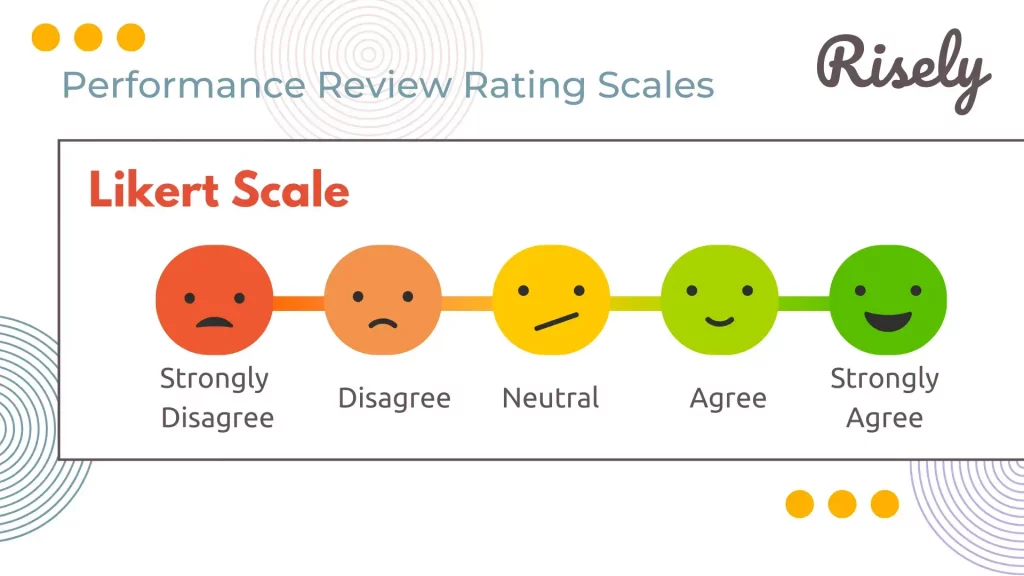
360-Degree Feedback Scale
A 360-degree feedback scale gathers input from multiple sources, including managers, peers, and subordinates. It provides a comprehensive assessment of an employee’s performance from different perspectives. This scale can identify blind spots and areas for improvement, promoting a holistic view of an employee’s performance beyond just manager evaluations. Consider using a 360-degree feedback scale as part of a well-rounded evaluation process.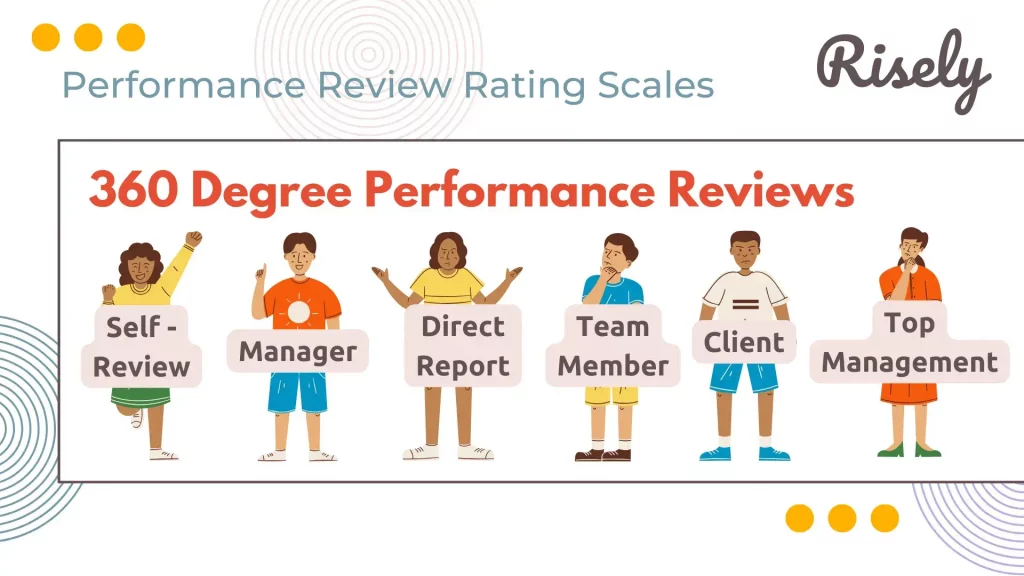
Forced-Choice Scale
The forced-choice scale is a performance review rating scale that requires managers to choose between two positive or negative options. This scale helps eliminate biases such as leniency or harshness, forcing managers to make a definitive choice. By using this scale, organizations can better understand employees’ areas for improvement and strengths. However, it’s essential to consider the organization’s culture and goals before implementing a forced-choice scale, as it may require additional time and effort.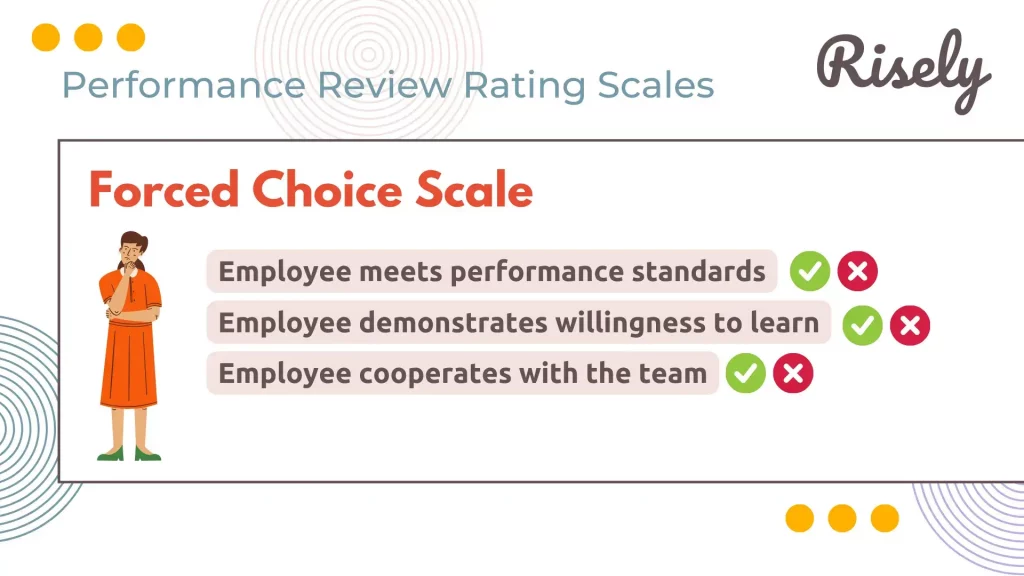
Paired Comparison Scale
The paired comparison scale involves comparing two employees simultaneously based on specific criteria. This method eliminates biases and allows for a more accurate assessment of employee performance. It is a flexible tool that can be adapted to fit the needs and goals of the organization. The paired comparison scale helps identify top-performing employees and those needing improvement. It provides a clear and concise way to communicate performance ratings to employees. The scale can also support strategic decision-making and talent management initiatives. But remember that this scale can get out of touch with standards while focusing heavily on specific cases.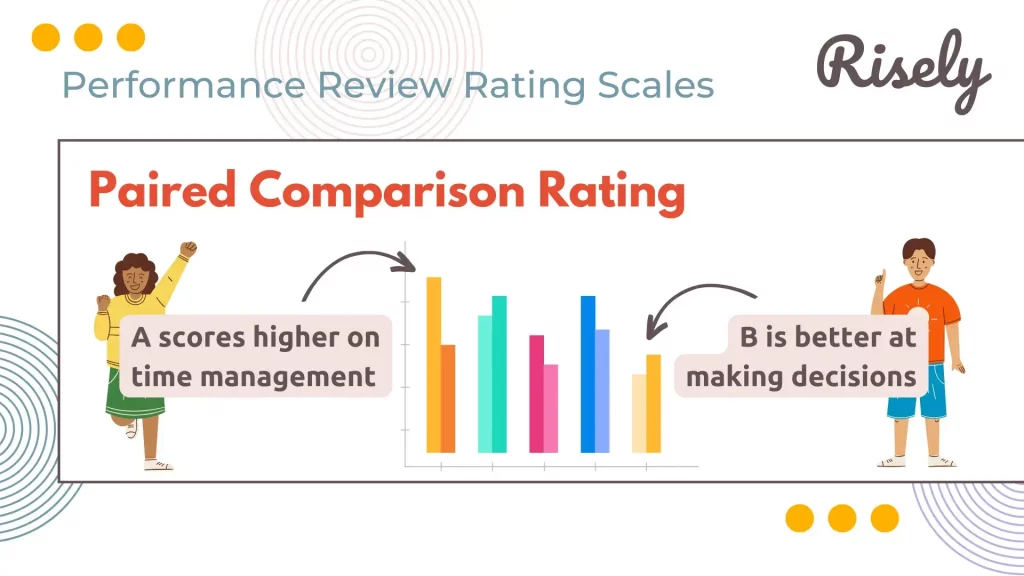
Essay-Style Scale
Essay-style scales offer a more detailed approach to performance reviews, allowing in-depth feedback and discussion. These scales can be tailored to the specific needs and goals of the organization, promoting critical thinking by managers instead of relying on simple grades. Using essay-style scales, areas for improvement can be identified, and future performance goals can be set. Additionally, this approach fosters trust and enhances communication between managers and employees. However, it is essential to note that implementing essay-style scales may require additional time and resources for training. Nonetheless, the scope for misunderstanding and difficulties in calibration is higher.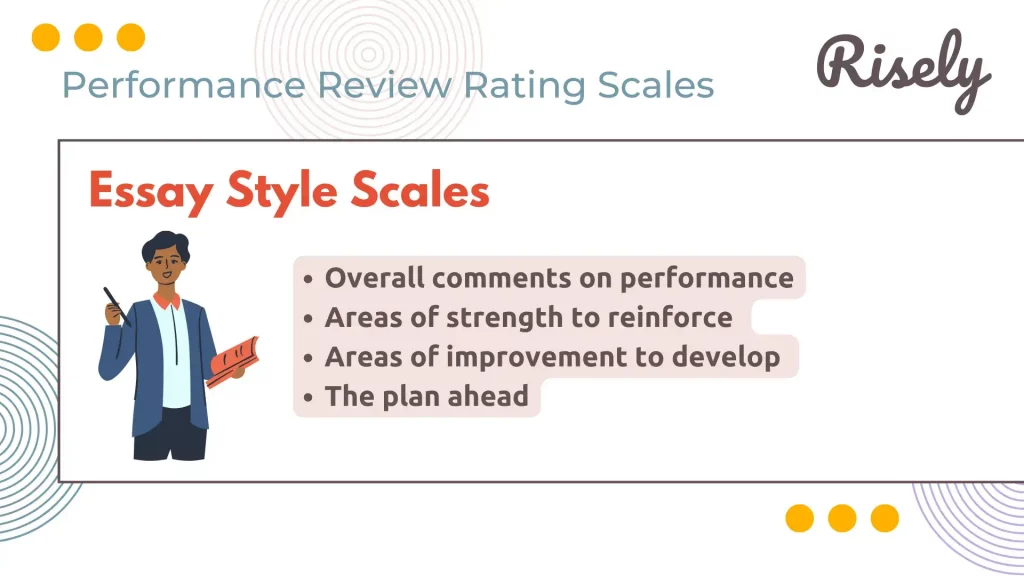
How to Create a Custom Performance Review Rating Scale?
Many organizations face difficulties in using the typical performance review rating scales. Sometimes, it’s the complexity of scales. The other is the reductive nature of ratings. Finding the balance becomes a challenge. Hence, some organizations have taken up to design rating scales based on their unique needs and provide insights they need.Step-by-Step Process
Creating a custom performance review rating scale involves defining the criteria, the rating levels, and the descriptions for each level. Here’s a step-by-step guide on how to create one:- Determine Evaluation Criteria: Identify the specific criteria you want to assess in the performance review. These could include job-related skills, competencies, behaviors, and goals. Ensure that the criteria are holistic and do not heavily focus on any singular aspect. Additionally, remember to create a high-level plan that can be customized for the needs of different roles.
- Select the Number of Rating Levels: Decide how many rating levels you want to include in your scale. Standard options include 3, 4, 5, or 7 levels, but you can choose the number that best fits your needs. Generally, it is good to rely on an odd number that provides a neutral choice and varied levels of performance and underperformance.
- Define Rating Levels: Create clear and distinct definitions for each rating level. These descriptions should indicate what constitutes performance at each level. Use concise and measurable language. Crafting these descriptions well is the key to fighting performance review biases by reducing the scope for misinterpretation. Use extreme descriptions to clearly define exceptional and poor performance for the highest and lowest ratings.
- Get your team onboard: Before implementing the custom rating scale organization-wide, consider piloting it with a small group to identify any issues or confusion. Refine the scale based on feedback. Ensure that all employees and managers understand how the custom rating scale works. Provide training or guidance on how to use it effectively.
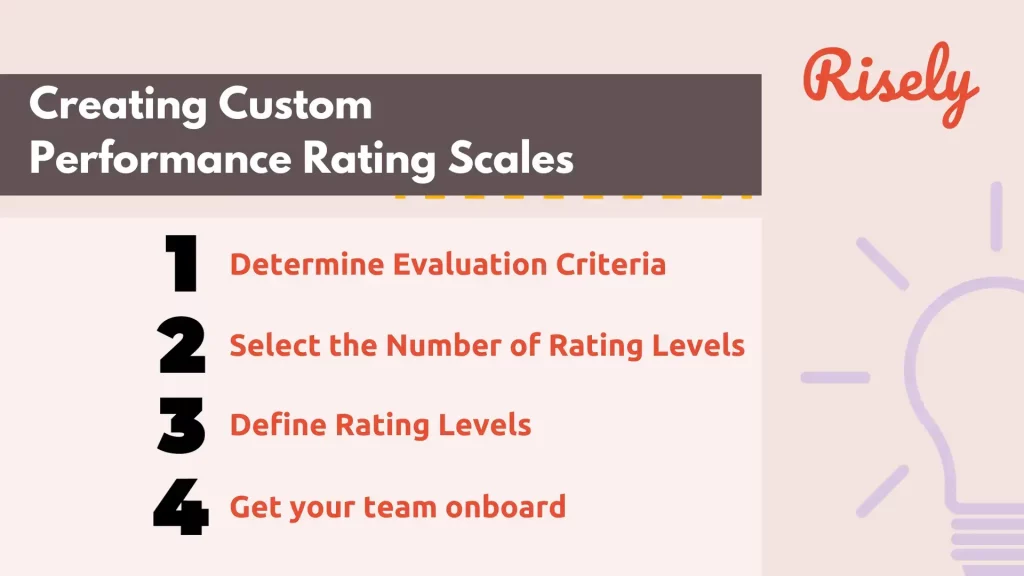
Best Practices for Implementing Performance Review Rating Scales
When implementing performance review rating scales, it is essential to determine the purpose of the review and align the rating scale accordingly. To avoid confusion:- Keep the scale simple and easy to understand.
- Use clear descriptions for each rating level to ensure consistent evaluations.
- Consider using a balanced scale to avoid bias or leniency.
Communication and Training
Clear communication and comprehensive training are crucial to ensure effective implementation of the performance review rating scale. Using simple and easy-to-understand language in the rating scale is essential, providing examples of behaviors that align with each rating level. Managers and supervisors should be trained on effectively delivering ratings and feedback. Regular evaluation and updating of the rating scale ensure accuracy and fairness.Consistency and Fairness
When choosing a performance review rating scale, it is essential to consider consistency and fairness. Align the scale with your company’s goals and values, ensuring it can be understood and used consistently across all departments. Avoid using vague or subjective language, and opt for a balanced scale with positive and negative feedback. Train managers and employees on effectively using the rating scale to promote evaluation fairness.Conclusion
Choosing the correct performance review rating scale is crucial for effective performance management. It ensures fairness, accuracy, and objectivity in evaluating employee performance. Factors such as employee engagement, simplicity, flexibility, and scalability must be considered while selecting a rating scale. There are various rating scales to choose from, including the Likert scale, 360-degree feedback scale, forced-choice scale, paired comparison scale, and essay-style scale. If none of these options meet your requirements, you can create a custom rating scale using a step-by-step process and following best practices to ensure effectiveness. By implementing the correct performance review rating scale, you can foster a culture of transparency, accountability, and continuous improvement in your organization.Worried about conducting performance reviews right? Master feedback!
Effective feedback lays the path to growth. Test this critical skill for your team today for free.
Other Related Blogs
How to build and retain high performing employees? | Laletha Nithiyanandan
How to build and retain high performing employees? | Laletha Nithiyanandan Are you really an HR if you have not spent hours chasing the ideal high performing employees for your…
How Can You Build A High Performing Culture? 7 Hacks
How Can You Build A High Performing Culture? 7 Hacks We have all heard of dream teams and tried to build them with varying levels of success and failure. Among…
10 Effective Manager Performance Goals to Drive Team Success
10 Effective Manager Performance Goals to Drive Team Success You’re sitting across from a manager in a performance review meeting. They seem unsure, disconnected from the company’s vision, and oblivious…
How to Build a High-Performing Team?
How to Build a High-Performing Team? Creating a high-performing team is a goal that every organization aspires to achieve. A high-performing team achieves superior results and can quickly adapt to…

